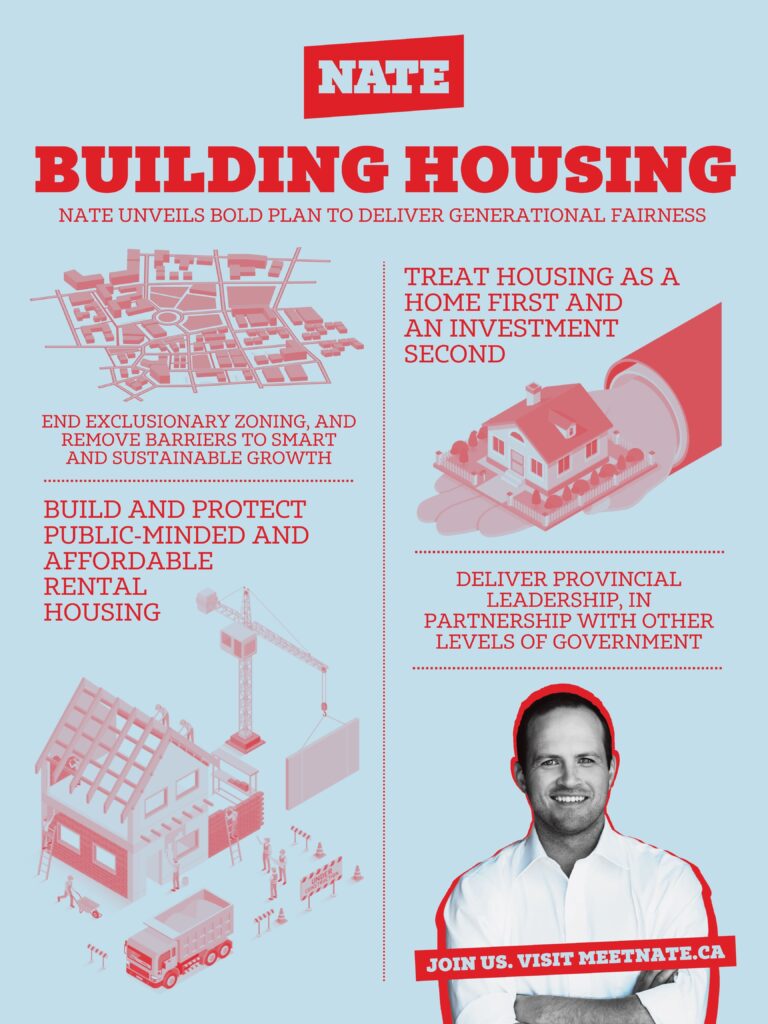A Bold and Ambitious Plan to Make Housing Affordable in Ontario
Nate's Vision
Ontario families are facing a massive housing crisis and deserve serious action.
It is a generational fairness challenge and a challenge to our economic productivity.
With home ownership out of reach and rents on the rise, young people are leaving their home communities and our province.
The next generation should be better off than the last, and hard work should be rewarded with a place to call home.
We need provincial leadership. We can’t afford more NIMBYism.

Nate's Plan:
- Ending exclusionary zoning, and remove barriers to smart and sustainable growth.
- Building and protecting public-minded and affordable rental housing.
- Treating housing as a home first and an investment second.
- Partnering with other levels of government.
BACKGROUNDER
Housing affordability is an economic and social crisis. According to CMHC, Ontario needs 1.85 million new homes to make housing affordable again. This plan acknowledges and responds to the fact that Ontario is not building enough housing – or quickly enough – to keep pace with our growing population.
We need ambition to make affordable housing a reality. If elected Ontario Liberal Party leader and Premier, Nate Erskine-Smith will eliminate barriers and improve density by:
-
Ending exclusionary zoning, and removing barriers to smart and sustainable growth
-
Building and protecting public-minded and affordable rental housing
These commitments have been supplemented by a Phase 2 announcement focused on affordable housing, including relevant northern and Indigenous strategies.
Ending Exclusionary Zoning
Allow fourplexes provincewide and study sixplexes
The province’s Housing Affordability Task Force recommended “as of right” residential housing up to four storeys on a single residential lot. At minimum, this recommendation should be accepted. In response to advocates who have called for sixplexes in their communities, further action must be explored. Many established neighbourhoods are seeing population decline, as single-family homes occupied by older people are out of reach for new families. Local schools are often under-enrolled; amenities like parks are under-used. Multiplexes allow for more families to live in the same area, offsetting population loss, providing entry-level home prices, bringing people closer to essential services, and providing seniors with options to downsize and stay where they have spent much of their lives.
Off-the-shelf plans for multiplex housing
Professional fees and lengthy review processes contribute to the largest costs in any housing project, small or large. Ultimately, these unknown costs often result in small projects being abandoned. By pre-approving off-the-shelf designs, many costs become fixed and approvals become certain, reducing risk and controlling costs for property owners. This is particularly important in Northern and rural Ontario, where designs tailored for that specific area will help to address higher construction and maintenance costs.
An Ontario design competition
Launching a provincial design competition will generate high-quality designs from architects and design firms to create a range of pre-approved plans for different property types. Municipalities could pick a number of plans for each property type so that local character is supported without losing new housing opportunities.
Province-wide zoning standards
Establishing province-wide zoning standards to facilitate six storey construction as of right near transit and modernizing rules like minimum parking requirements, heights, density, minimum lot sizes and angular planes, will make it easier to build homes while addressing environmental impacts.
Building and Protecting Public-Minded and Affordable Rental Housing
Protecting existing affordable rental stock
A substantial amount of Ontario’s publicly-owned affordable housing stock is in a state of disrepair. Many units cannot be occupied at present. Substantial investments – in partnership with other levels of government – is required to improve and preserve the quality of affordable housing, ensuring this important resource is not lost, even as we invest in new units.
Creation of a public builder
It is clear that Ontario needs to get back into the social housing space. Phase 2 of our Housing Plan will provide more information about this policy.
Immediate, targeted investments in specific areas of need
It will take time for any new public builder/entity to be set up, especially one with a mandate to build directly. It will be important that new builders provide the existing ecosystem with resources to develop shovel-ready projects. Northern housing is a specific area of need, where government financing mechanisms and ownership can support the construction of housing and maintain long- term affordability.
Student housing
When there is an increased demand for local housing for international students, there is upward pressure on rents and students are often forced into substandard or unsafe housing conditions. We will work with colleges and universities to align on appropriate targets for housing, on and off campus, and enrollment.
Housing-first approach to chronic homelessness
Housing First is a homeless assistance approach that prioritizes permanent housing for people experiencing homelessness. It ends individuals’ homelessness and serves as a platform from which they can pursue personal goals and improve their quality of life. Phase 2 of the housing plan will show how stable funding and new investments in housing can enable this approach to succeed across Ontario.
Treating Housing as a Home First and an Investment Second
Stronger tenant protections
Renters in Ontario need predictability and fair dealings with their landlords. We will put stronger tenant protections in place and add resources to reduce the Landlord and Tenant Board (LTB) backlog, as well as effective regulation and protection of multi-tenant homes.
A beneficial ownership registry
We will improve transparency through a beneficial ownership registry, which requires companies holding real estate to identify their beneficial owners and maintain records that are to be submitted and kept current with the government. This helps combat money laundering by providing law enforcement with a means of investigating illegal activities without first flagging an interest through a request for beneficial ownership information through an entity like a numbered company.
Making it harder to demolish multiple homes for luxury mansions
It is commonplace for multiple lots – each containing individual homes – to be bought, merged, and demolished so a single mansion can be built where multiple family homes once stood. This reduces the amount of housing in neighbourhoods that are often already experiencing population decline, forcing families further away from essential services and community amenities like schools. We will explore the use of planning policies and the elimination of counter-productive development charge exemptions to address this problem.
Legalizing multi-tenant housing
Multi-tenant housing, where “roommates” share units with all names on a rental lease, is prohibited in certain communities. Multi-tenancy continues to happen informally, leaving renters with limited legal protections. We will correct this and unlock affordable rental options by legalizing multi-tenant housing provincewide.
Phased-in rent controls
Immediate (or “hard”) rent controls on new buildings can reduce the ability of rental companies to adjust rents to accommodate various unforeseen costs and service requirements after a building is newly completed. This creates a level of risk that can deter new investments in purpose-built- rentals. We will implement phased-in rent control, which reaches a hard cap over several years. This will limit opportunities for price gouging, protect rents in the long term, and allow builders greater certainty.
Limiting appeals on purpose-built rental housing
Today, third-party appeals can be filed with the Ontario Land Tribunal (OLT) to oppose new rental buildings on frivolous grounds. All available tools must be explored to reduce delays on housing projects, including higher thresholds, reviewing costs, and disallowing appeals in prescribed circumstances.
Increasing land transfer tax for investors that do not add housing
We must discourage money from being parked in housing real estate purely as an investment. Where single-family properties are converted into multiplexes and new housing opportunities are created within a reasonable period of time, these taxes on multiple-property owners would be waived. These taxes would not apply to properties purchased as multiplexes. Together with rules making it harder to consolidate lots for fewer homes, this push-pull policy will discourage property hoarding and encourage densification.
Revenue to support tenants at risk of eviction
We will use the revenue from this tax increase to expand rent bank programs, which help tenants cover critical costs during financial emergencies, such that they can stabilize and not lose their homes.
Enabling municipalities to introduce progressive property taxation
We will allow municipalities to tax properties incrementally. A property could have a base rate applied up to a specified limit and a higher rate on sale values above that.
Pilot a system that levies different rates depending on how the land is used
A split-rate land tax allows for the land itself, not the property on it, to be a larger factor in taxation. This can be a powerful tool for encouraging more efficient land use near amenities, transit, and other community infrastructure. We will explore a pilot program that municipalities could opt into as a means to evaluate the benefits for potential future expansion.
Partnership with Other Levels of Government
Housing growth numbers are far below where they should be. Municipalities need support and respect, but also need to be challenged to expand residential development near transit and jobs. The current approach of leaving municipalities to reject housing and embrace NIMBYism does not work. For example, Mississauga has lost 3,600 people as of the 2021 census and built less than 16,000 homes over the last decade. It doesn’t have to be that way.
We will reverse the Conservative government’s decreased density targets and ensure municipalities grow without sprawling by providing them with the resources that they need while making sure they are accountable to land use planning laws and the public interest.
Delivering skilled trades that are needed
A federal-provincial skilled trades strategy that lowers barriers for new Canadians to enter the skilled trades in areas like home construction, and provide funding and support for training programs, must be developed. Incentives should target Northern and rural communities that have faced acute labour shortages.
Top-up funding for municipalities
Planning auditor
Acting with Urgency and Seriousness
It has become highly common for politicians of all stripes to talk about housing without taking action. The Conservative government announced a goal of 1.5 million new homes over 10 years and appointed an expert housing task force to advise on its work, but then acted against that advice, embraced urban sprawl and started selling the Greenbelt.
These choices have exacerbated the problem. 50 years ago, a young person worked for five years to save a 20% down payment on an average home. Now, it takes 22 years across Ontario and 27 years in the GTA.
Ontario Liberals who want a future where young workers and families can afford to stay in their communities know that there’s another way. We can’t afford more NIMBY-ism. We need an ambitious and serious plan.
